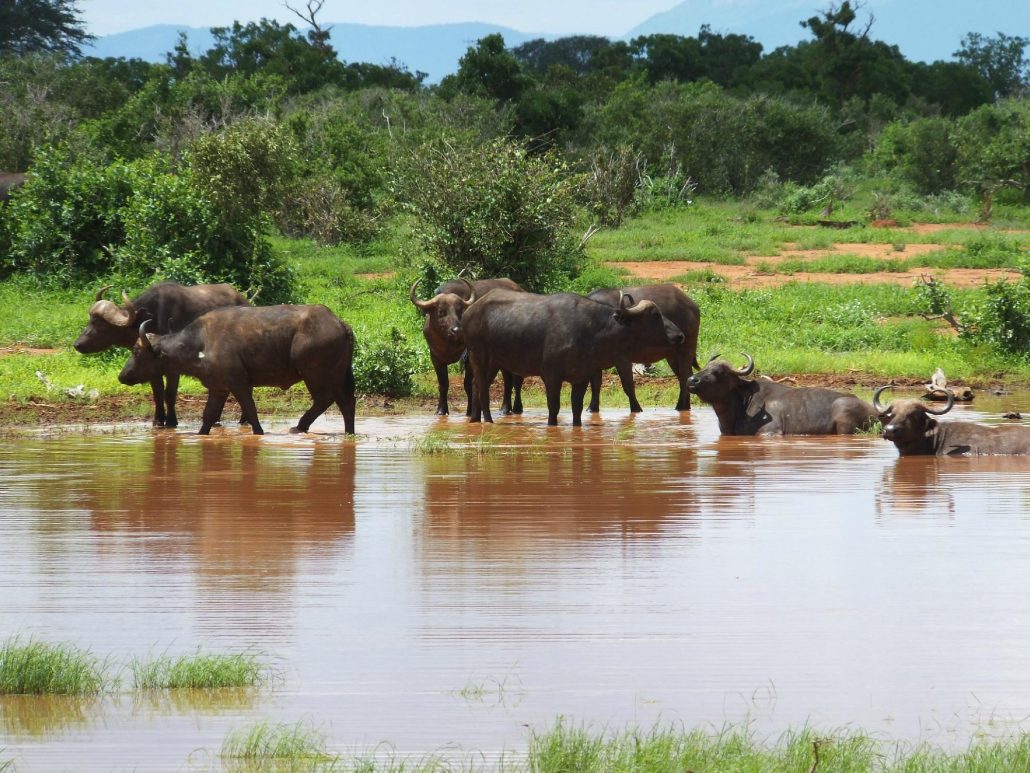Tsavo East National Park
Tsavo East National Park, part of the larger Tsavo National Park, is one of Kenya’s oldest and largest national parks, covering an area of approximately 11,747 square kilometers (4,536 square miles). Established in 1948, Tsavo East is located in the southeastern region of Kenya, straddling the highway that connects Nairobi to Mombasa. The park is renowned for its stunning landscapes, diverse ecosystems, and rich wildlife, making it a prime destination for safari enthusiasts. The terrain varies from savanna grasslands and acacia woodlands to riverine forests and volcanic hills, providing a diverse habitat for numerous animal and bird species. The park is also known for its iconic red soil, which is a result of volcanic ash, giving the park a distinctive appearance.
 The Tsavo River flows through the park, creating vital water sources that support wildlife, especially during the dry seasons. Tsavo East is home to a variety of landscapes, including the Yatta Plateau, one of the longest lava flows in the world, and Mudanda Rock, a natural viewpoint that offers breathtaking views of the surrounding areas. The park is not just a sanctuary for wildlife; it also holds cultural significance, with local communities living around its periphery.
The Tsavo River flows through the park, creating vital water sources that support wildlife, especially during the dry seasons. Tsavo East is home to a variety of landscapes, including the Yatta Plateau, one of the longest lava flows in the world, and Mudanda Rock, a natural viewpoint that offers breathtaking views of the surrounding areas. The park is not just a sanctuary for wildlife; it also holds cultural significance, with local communities living around its periphery.
Wildlife Scenery
Tsavo East National Park boasts an impressive array of wildlife, making it a hotspot for animal lovers. The park is home to large herds of elephants, which are often seen dusting themselves with the characteristic red soil, giving them a unique and memorable appearance. Other prominent species include buffalo, giraffe, zebras, and various species of antelope, such as kudu and impala. The park’s ecosystem is also supported by the presence of predators like lions, leopards, and cheetahs, which can often be spotted resting under the shade of acacia trees or stalking their prey across the open plains.
The scenery in Tsavo East is stunningly diverse, with vast savannahs dotted with acacia trees, open grasslands, and rocky hills, all of which provide unique habitats for wildlife. The Kangundo Hills in the backdrop enhance the beauty of the landscape, offering picturesque views that make the park a favorite among photographers and nature enthusiasts. The Tsavo River, which meanders through the park, attracts various animals seeking water, especially during the dry season. This combination of diverse habitats and abundant water sources makes Tsavo East a vibrant and vital sanctuary for wildlife.
Birds
Birdwatching in Tsavo East National Park is a rewarding experience, as the park is home to over 500 bird species. The diverse habitats within the park attract a wide range of avian life, from large raptors to colorful songbirds. Notable bird species include the African fish eagle, vultures, secretary birds, and the Kori bustard, which is one of the heaviest flying birds. The park is also a haven for migratory birds, particularly during the rainy seasons when many species flock to the area.
Birdwatchers can explore the riverine forests along the Tsavo River, where they may spot species like the African black duck and various kingfishers. The open savannahs provide a habitat for ground-nesting birds such as the white-bellied bustard and numerous finches. The park’s diverse ecosystems create opportunities for birdwatchers to observe a variety of species in their natural habitats, making it a fantastic destination for both amateur and experienced ornithologists.
When Is the Best Time To visit Tsavo East National Park?
The climate in Tsavo East National Park is characterized by a warm, semi-arid environment with distinct wet and dry seasons. Average temperatures range from 20°C (68°F) to 30°C (86°F) during the day, while nighttime temperatures can drop to around 10°C (50°F). The park experiences two main rainy seasons: the long rains from April to May and the short rains from November to December. These rains rejuvenate the park’s vegetation and attract wildlife, making it an excellent time for game viewing.
The dry season, particularly from June to October, is also popular among visitors, as animals tend to congregate around water sources, making them easier to spot. The dry months provide clear skies and excellent visibility, perfect for photography and wildlife observation. Overall, the weather and climate in Tsavo East contribute to its unique appeal, with visitors enjoying the stunning landscapes and rich wildlife throughout the year.
Getting To Tsavo East National Park
Tsavo East National Park is easily accessible by both road and air. The park is situated approximately 150 kilometers (93 miles) from Mombasa and 300 kilometers (186 miles) from Nairobi. Visitors traveling by road can take the Nairobi-Mombasa highway, turning off at Mtito Andei for the entrance to the park. The drive from Nairobi typically takes 4 to 5 hours, while the journey from Mombasa is about 2 to 3 hours.
For those preferring to fly, several airstrips serve the park, including the Tsavo East Airstrip and Satao Airstrip, which cater to charter flights from Nairobi and Mombasa. These flights provide a scenic aerial view of the landscapes below and offer a quick and convenient way to reach the park.
Activities to Engage In Tsavo East National Park
Tsavo East National Park offers a wide range of activities for visitors to immerse themselves in the natural beauty and wildlife of the area. Some of the popular activities include:
- Game Drives: The primary attraction in Tsavo East, game drives allow visitors to explore the park’s diverse landscapes while searching for wildlife. Early morning and late afternoon drives are often the most productive for spotting animals.
- Guided Walks: For a more intimate experience with nature, guided walking safaris provide an opportunity to learn about the flora and fauna from knowledgeable guides. These walks allow for closer encounters with smaller wildlife and a chance to appreciate the park’s biodiversity.
- Birdwatching: With over 500 bird species present, Tsavo East is a paradise for bird enthusiasts. Birdwatching can be enjoyed throughout the park, especially near water sources and in the riverine forests.
- Photography: The stunning landscapes and diverse wildlife make Tsavo East an ideal destination for photography. Visitors can capture breathtaking images of animals, the unique scenery, and the vibrant colors of the African savannah.
- Cultural Visits: Engaging with local communities around the park provides insight into the rich cultural heritage of the Taita and Kikuyu people. Visitors can learn about traditional practices, crafts, and the harmonious relationship between the communities and wildlife conservation.
- Camping: For those seeking a more adventurous experience, camping within designated areas of the park allows visitors to immerse themselves in the wild, listening to the sounds of nature at night.
- Visit to Mudanda Rock: A unique geological feature in the park, Mudanda Rock offers panoramic views of the surrounding landscape and wildlife. It is a great spot for picnics and relaxation while enjoying the scenery.
Safety and Vaccination
When visiting Tsavo East National Park, safety is a priority for both visitors and wildlife. The park is generally safe, but visitors should take standard precautions. It is essential to follow the guidance of trained park rangers and adhere to the park rules, particularly regarding interactions with wildlife. Staying within designated areas and maintaining a safe distance from animals is crucial for personal safety and the well-being of the wildlife.
Vaccination recommendations for travelers to Tsavo East include routine vaccinations and those for yellow fever, hepatitis A, typhoid, and rabies (especially for those planning to stay for extended periods or engage in wildlife interactions). Although the risk of malaria is lower in the Tsavo region, visitors should consult with a healthcare professional regarding malaria prophylaxis, especially if traveling to other areas of Kenya. It’s advisable to use mosquito repellents and wear protective clothing during dusk and dawn when mosquitoes are most active.
Park Rules
To preserve the integrity of Tsavo East National Park and ensure a safe experience for visitors, the following park rules must be observed:
- Stay on designated roads and tracks: Off-road driving is prohibited to protect the environment.
- Do not feed or approach wildlife: Maintain a safe distance to avoid disturbing animals.
- Follow the instructions of park rangers: Always adhere to the guidance provided by park staff for your safety.
- No littering: Dispose of waste responsibly to keep the park clean and protect wildlife.
- Quietness: Maintain a low noise level to avoid disturbing wildlife and enhance the experience for all visitors.
- Camping regulations: Only camp in designated areas with prior permission.
In summary, Tsavo East National Park is a captivating destination that offers visitors a chance to experience the beauty of Kenya’s wildlife and landscapes. With its diverse ecosystems, rich biodiversity, and array of activities, Tsavo East is a must-visit location for anyone seeking an authentic African safari experience.
